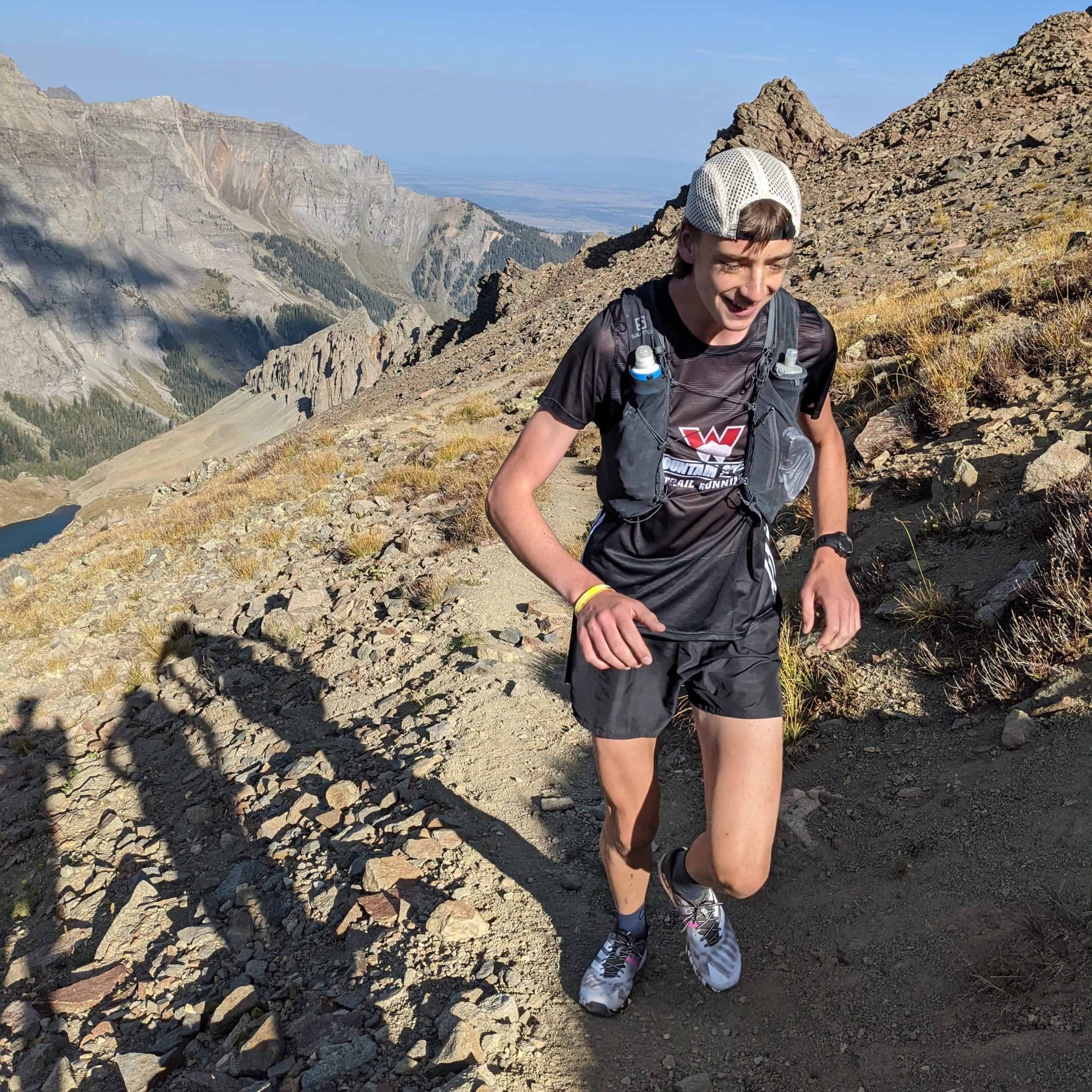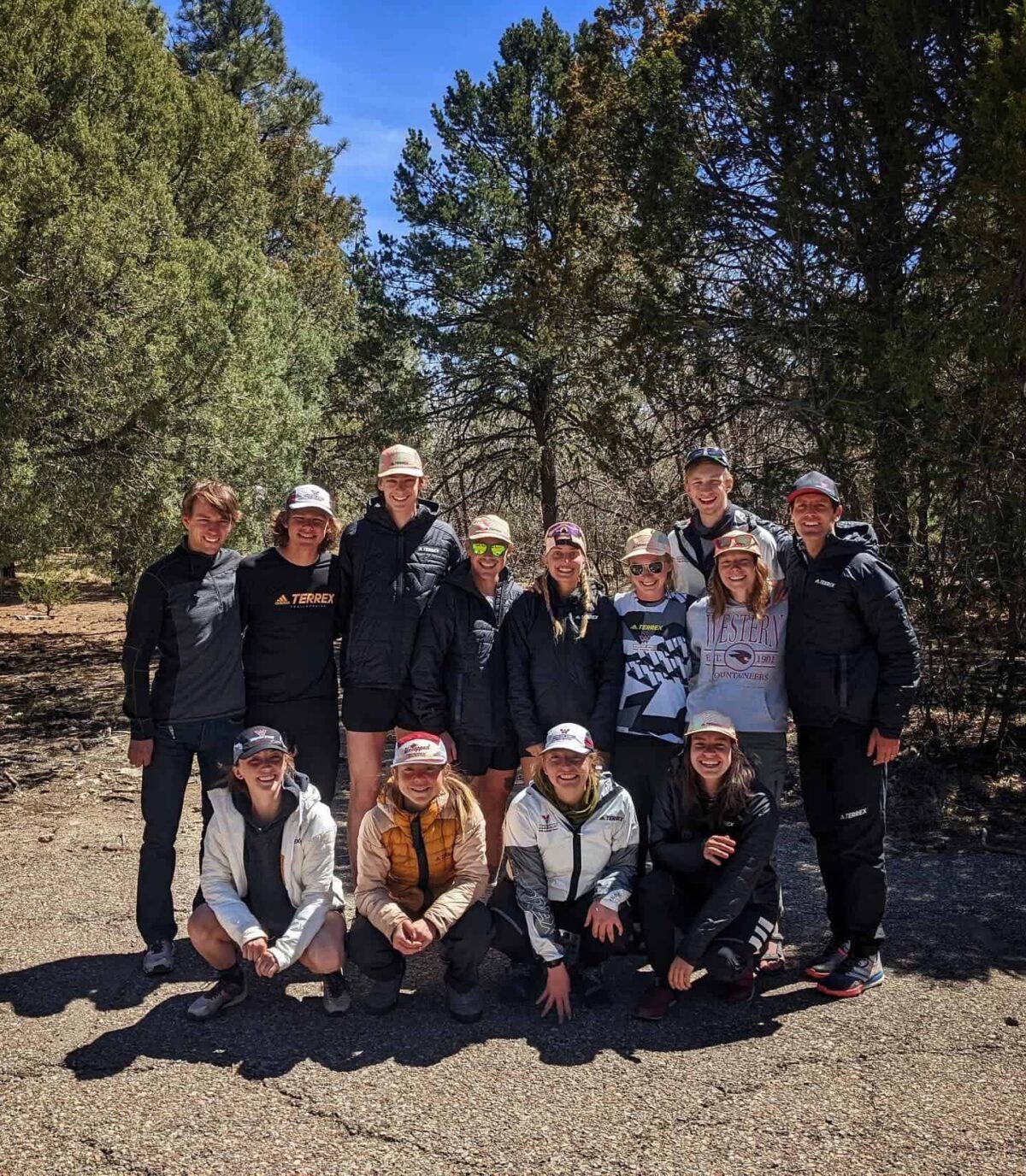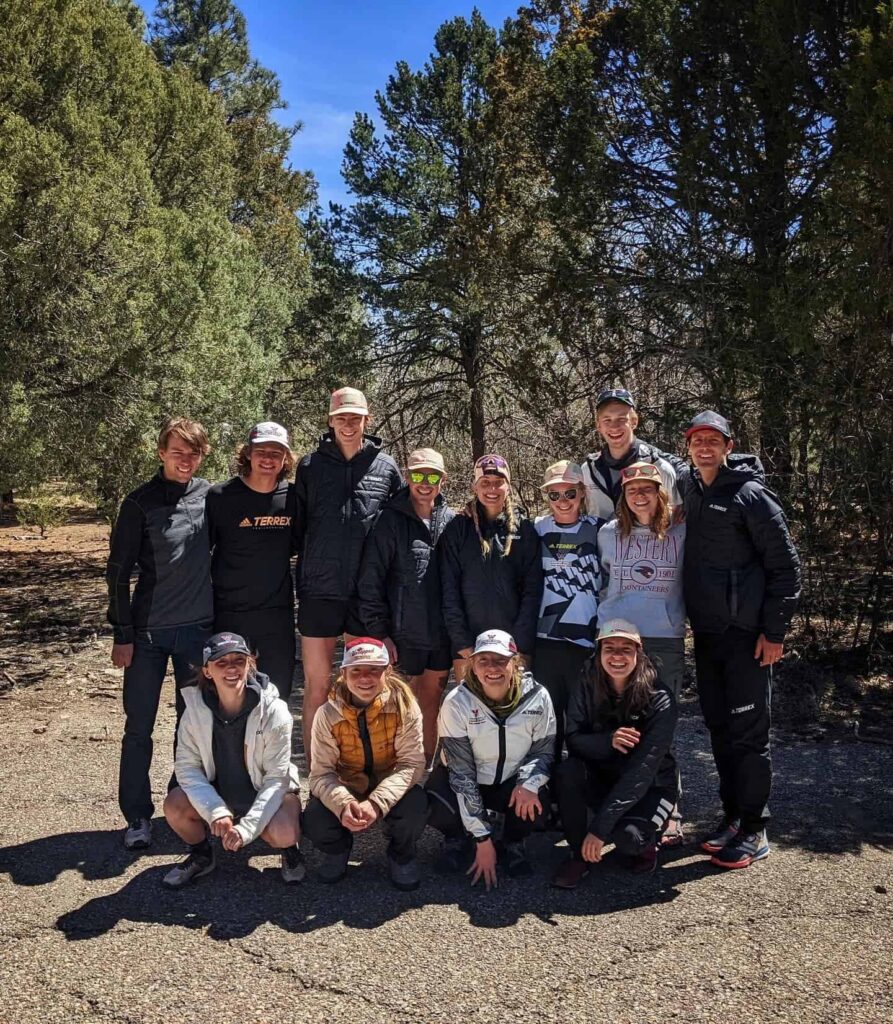
“Come March of 2020 when the world had ended, I was just bored out of my mind with online school. And one day running really clicked and just became a lot more fun than it had been. The rest of my junior year of high school and into my entire senior year of high school, I just ran by myself,” says rising Mountaineer sophomore Jack Breezley, a member of Western’s trail running team.
Breezley, a Recreation and Outdoor Education (ROE) major, came to Western to train and compete with the team. During the winter, he races for Western’s ski mountaineering team —which he describes as essentially the winterized version of trail running. Unlike many trail runners, Breezley never ran competitively in high school on the track or cross-country teams before turning to the trail.
Western’s growing repertoire of Mountain Sports programs features seven distinct sports, including climbing, alpine skiing, and mountain biking. Among those offerings, trail running stands out in the sense that it requires little in the way of technical gear for athletes to get started.
Despite the seemingly low barrier to entry, the growing sport rewards intensive training, plenty of grit, and long, hard days (and often nights, during races) among the mountains.
Caroline Benney is a Western senior studying Spanish. Originally from Leadville, she came to trail running from a background in Nordic skiing and cross-country, but arrived at Western primarily to join the mountain biking team.
“Over Covid, I just started running again for cross training and fell in love with it all over again,” adds Benney, who previously competed for Western’s Nordic team. Nordic skiing in particular sees a large amount of athlete crossover with the trail running squad.
This summer, Benney is focusing on the shorter courses, noting that a 50-mile course she ran last year was especially tough on her body — so she’s sticking to the short courses for the time being.
Short, of course, is a relative term in trail running, where races can run up to 100 miles or more. But Benney prefers heart-pounding, shorter fare. “I love vert. I love to run uphill,” she adds.
Helping tie the team of more than a dozen athletes together is Lindsey Herman, Western’s assistant Trail Running coach. “I came to Western for skiing really,” Herman says. “I grew up alpine ski racing…and I didn’t do the traditional cross country and track background, but I always enjoyed running.”
After her freshman year at Western, Herman suffered a knee blowout, an experience which effectively ended her ski racing career. While Herman competed on the trail running team all four years of college, she ratcheted up the intensity her last two years — graduating and quickly beginning her assistant coaching role that fall.
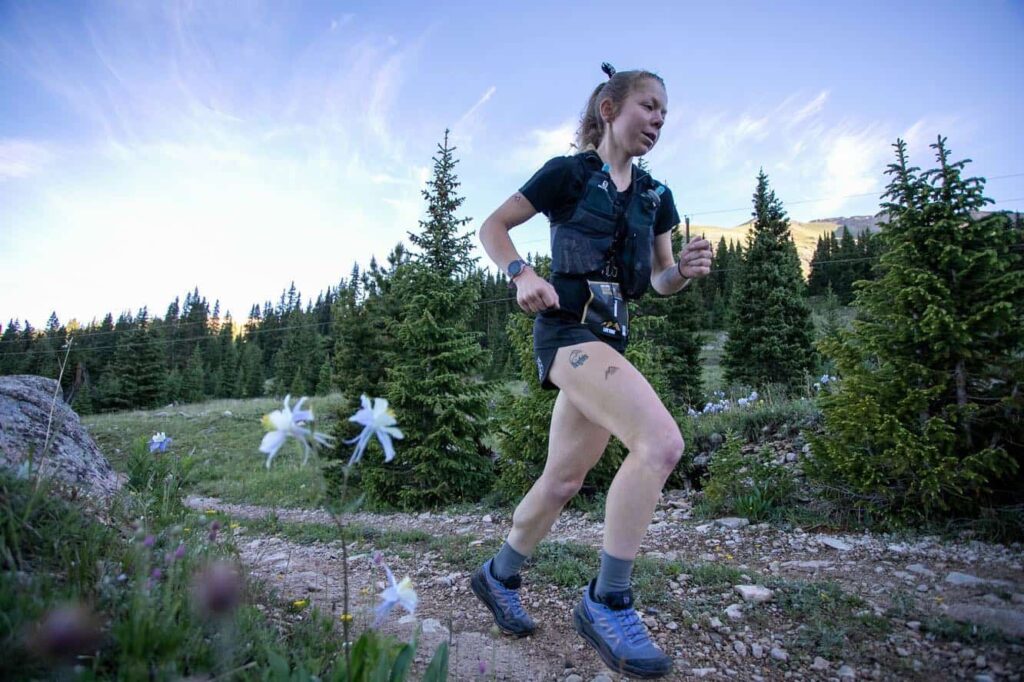
Training for the trail
Training for high-level trail runners is a year-round affair, and athletes will often cross train with other cardio-intensive sports like ski mountaineering or Nordic skiing to keep up their cardio, stay fresh mentally, and hopefully save some strain on their legs.
The fall race season typically gets underway with a bang in September and October, and features desert events into November, like the Moab Marathon — slated for Nov. 5 and 6 this year. When the snow clears in the spring, athletes will gear up for races in the desert and at lower elevations in April and May.
This year, Western’s athletes competed in officially sanctioned summer races for the first time—part of a new sponsorship deal with Adidas Terrex. “We’re keeping these races super optional because it’s not NCAA and we don’t want people to get burnt out — we want people to love running,” says Herman.
Managing physical stress loads and preventing injury is constantly top of mind for trail runners. That’s where strength training comes in — enabling athletes to build up their bodies to survive the wear and tear of rigorous training and racing.
Over this last winter, Benney battled a stress response in her tibia that sprung up as a result of high training impact. “I struggled with my nutrition, and I really learned from my stress response that I needed to incorporate a better diet,” she adds.
Before training and racing, the team also utilizes what are called “dynamic movements” — staples like high knees and flutter kicks — “stuff to get the joints ready for the impact,” notes Breezley.
After a hard day of training, Breezley places a high degree of importance on getting the proper nutrition — but just getting the replenishment calories into his long, skinny 18-year-old frame after a day of rigorous training can be a bit of a challenge. “I just have to eat a ton to make sure my body can recover,” he adds.
During long races, athletes have to be able to consume calories on the trail. So, during their lengthier training runs, the team will practice eating — training the body to ingest food while its hard at work. Energy gels — essentially a quick shot of sugary apple sauce, are a go-to.
“The average person should be taking in some sort of carb or sugar about every 45 minutes,” says Benney, who adds that her sensitive stomach largely limits her to drinking energy goo. More recently, she has been experimenting with some more exotic offerings, like tater tots.
Coach Herman is sponsored by a Canadian maple syrup company, UnTapped. “Their gels are literally pure maple syrup, and for [a race last year] I was fueled pretty much the entire time on pure maple syrup,” says Herman.
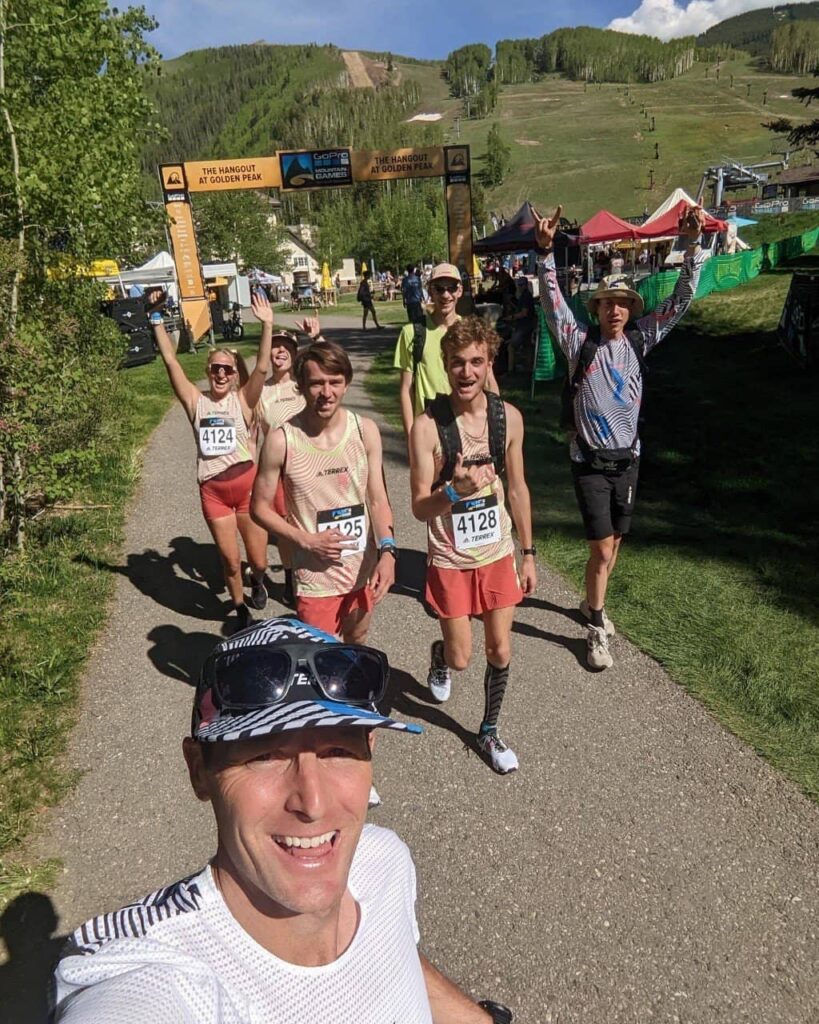
Building off recent success
This last year, Breezley and Benney’s training has paid off with a number of strong finishes.
Back in October 2021, Breezley ran the Crested Butte Ultra 55k, finishing 17th out of a field of more than 160 competitors. At just 18, he was a full half decade younger than the other top finishers.
Breezley followed that performance with a ninth-place finish at the Sageburner 28K, the annual Hartman Rocks race — clocking in at 2:44.38 before a late season injury derailed the remainder of his running season.
Breezley is particularly fond of the ultra distances, which he attributes to the fact that he never ran organized cross country or track. Back in early June, he competed in the 30-kilometer race at Durango Skyline, finishing seventh out of more than 50 competitors with a time of 3:22.21.
Benney — back for one more season next year before she graduates, is coming into her stride as well. At the June 12 Vail GoPro Mountain Games, she notched third in the women’s 20-29 age division for the 10K, and took fourth in the women’s 5K.

Navigating the world of sponsorships
In the world of ultrarunning, and of trail running more generally, sponsorships — largely from gear, beverage and food companies — play a significant role in the landscape, and allow top-level athletes to dedicate larger shares of their time to training. They also help athletes, and teams (including Western’s), alleviate the significant costs that come with travel and competition.
Breezley just inked his first official sponsorship deal with Tailwind Nutrition, a Durango-based company that makes electrolyte mixes for water. Coming off a strong skimo season, Breezley is exploring options to make trail running and skimo into a professional endeavor, but admits the process can be intimidating — even when dealing with a new industry player like Tailwind.
“I reached out to Tailwind on my own, and I was like ‘hey, I’m young, I live in Durango half the year, and I’m coming off a really good year of racing, and they were super stoked to bring me on,” he adds.
Coach Herman is also in the process of exploring the world of sponsorships, and says she is trying to develop her own personal brand as an athlete. “Nowadays, a lot of brands focus on results, but there’s also an emphasis on having an interesting story that people connect to, and social media is huge,” says Herman.
“As an athlete, I think it’s important to know what you’re worth. I think a lot of brands have these brand ambassadors, but you’re not actually getting that much in return from the brand,” she elaborates.
Herman is searching for a more mutually beneficial partnership, and says she isn’t afraid to hear the word no along that journey. She’s currently talking to three different brands, and exploring the field.
More holistically, Herman is in the process of syncing her brand as an athlete with her coaching brand, and her artistically-minded roommate is helping her create a logo to further her nascent brand’s promotion.
“What I’m looking for really is a brand that’s just as invested as me — and invested long term —because there are different lengths of contracts,” she says. “Some brands now will sign two or three-year contracts, which I think is really important.”
“If it’s just a year — what if you get injured? You want a brand that understands that injuries happen, and not every race is going to go well. I think it’s really important to ensure that there’s not that pressure to perform at every single race, because it’s never going to happen.”
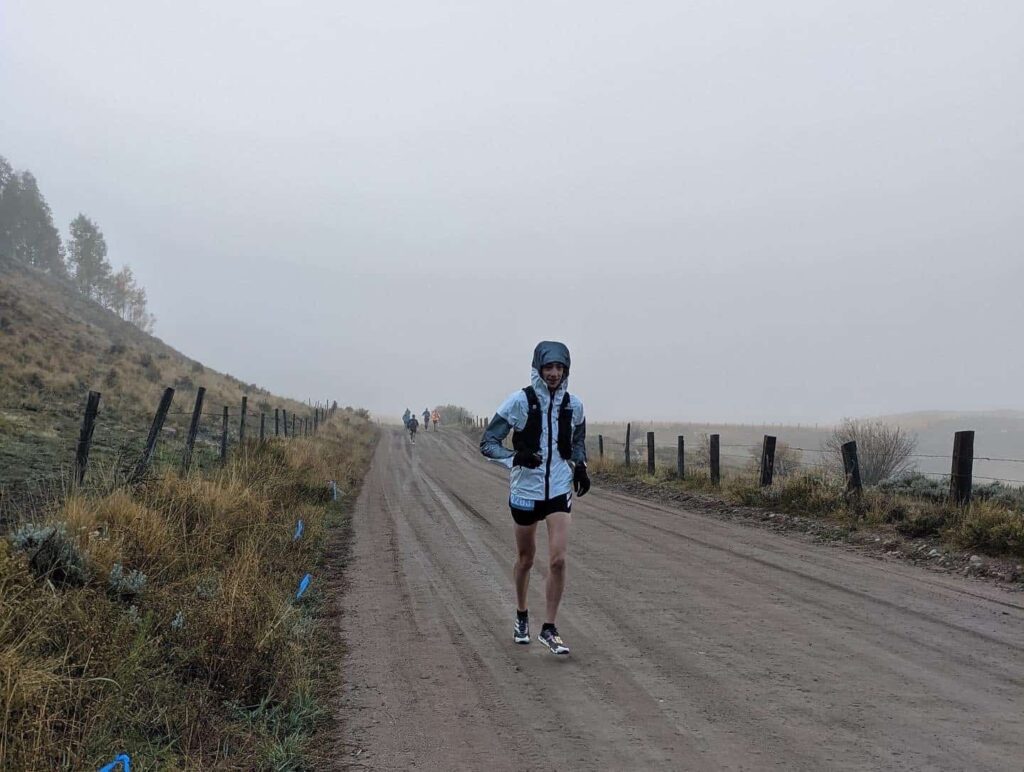
The culture of trail running
Every athlete has their own reason for pushing their limits in the world of trail running, competing in a sport that many would consider to be a grueling punishment.
For Breezley, trail running is a mechanism to explore his own personal limits, and to explore beautiful mountain landscapes.
“I really just want to explore how far I can go,” he says. “I want to get into that super remote spot in the mountains — or cross that mountain range in one day, or in one push…I get inspired by these super challenging and difficult objectives that seem almost impossible to most people.”
Currently, Breezley is pushing himself towards running a 100-mile race — a feat he thinks he could likely accomplish today but is saving for the future.
“I’m keeping an attitude where I’m saving it for a year or two down the road when I will be even stronger, and I’ll actually be able to run it well and have more fun,” he offers.
Coach Herman notes that there’s a team policy that limits the athletes to 50-mile-and-under races when they’re competing under the Western banner. The policy is intended to protect the young athletes from extraordinary strain on their bodies that could prematurely end their running career.
This summer, Breezley is busy training up his mountaineer skills independently down in his hometown of Durango — chasing fastest known times on peak routes.
When he’s training and competing with the team, Breezley says that the atmosphere of Western’s team helps push the athletes to the next level. “We push each other at the races, we’re hyping each other up each morning — pushing each other to run even if we’re not having a good day.”
But he admits that it’s easy for outsiders to become intimidated looking in at Western’s trail running team, and by the concept of mountain sports more broadly.
“It can be intimidating coming into this [atmosphere]…but what’s really cool about the trail team and the skimo team is the communities we’ve built within the teams, we’re so inclusive and open-minded. You could come into the trail running team with no running experience, and as long as you’re willing to work you are going to fit in perfectly on the team,” he adds.
In that same vein of inclusivity, Benney wants to fight the notion that trail runners have to look a certain way. Sometimes, she says, certain competitors get written off right at the starting line — typically based on preconceived notions of what a trail runner should look like. Those racers, she adds, can end up among the race’s top finishers when all is said and done.
Speaking to the broader accessibility of trail running, Herman wants to ensure that the sport of trail running remains open to women, who she notes can be intimidated by the prospect of running on remote trails.
“Most of the time when I’m running on trails, I rarely see other women — and I very rarely see other women by themselves,” she adds. “I think there’s something that keeps people from doing it because it feels unknown — going out into the wilderness or into the mountains can feel really vulnerable.”
But Herman encourages women to give it a go, while taking safety precautions. She adds that trail running can often become a second career for runners who have grown a bit tired of running on tracks. “A lot of people have revitalized their love for running when they come over to [trail running] after being a bit burnt out,” she says.
While she’s personally motivated by big races and performance goals, Herman is trying her best to take a long-term perspective and simply enjoy the ride, noting, “I think when you get too results-oriented, that can lead to an unhealthy mindset.”
For her, ultrarunning has become a staple of her everyday routine — plus, she genuinely loves running. “I enjoy that you have no other option than to focus on what you’re doing right then — it keeps you very present. You can’t worry about writing an email or doing anything else.”
She also just appreciates the utter simplicity of the sport. “It can be distilled down to being very simple, and I feel like that adds to the sense of accomplishment. It’s you and your two feet climbing up this mountain.”
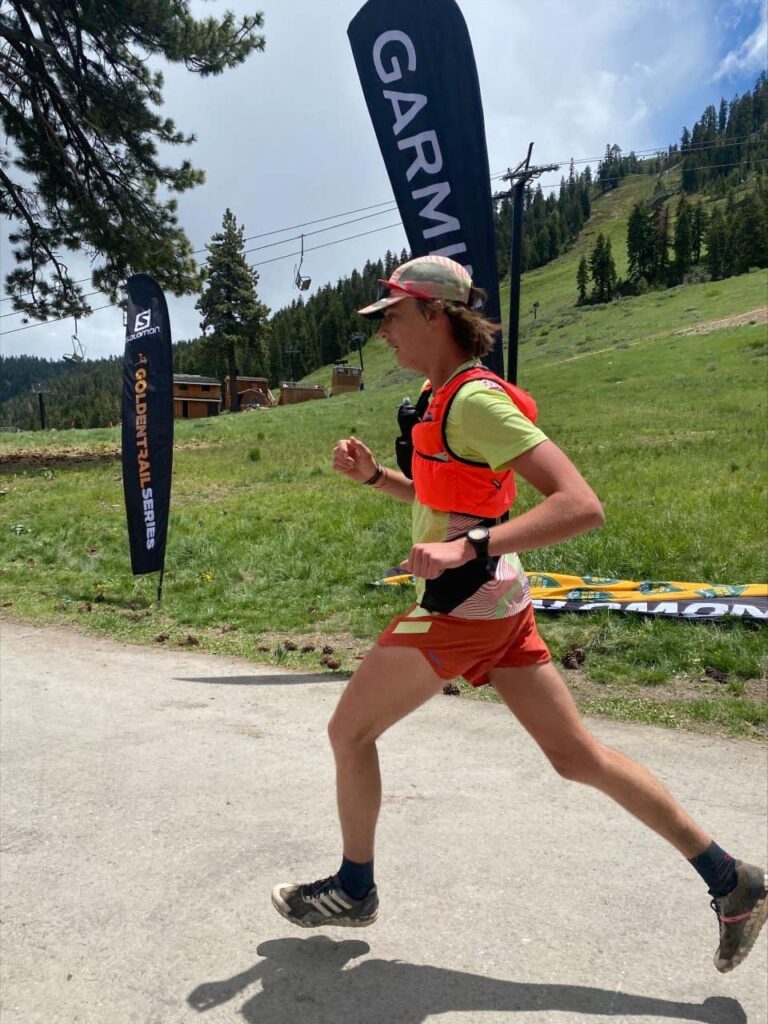
The coaching element
When it comes to the coaching realm, Herman sees her role as guiding athletes on their individual journey. “It’s a very individual approach — we try to read each athlete. It really is one of those things where [athletes] get out of what they put into it,” she adds.
Whether athletes come to the trail running team predominantly for the social aspect, with a hyper-specific race in mind, or just generally want to win and test their upper limits — the trail running team can accommodate almost any person and their ensuing goals. “It makes the team more special that we have that wide range,” says Herman.
Outside of Western’s team, Herman has her own coaching business — Running Wild, where she advises clients from across the nation. As Herman is quick to note, those relations go far beyond dispensing specialized running regimes.
“I have a real mix of athletes. I don’t coach any professional runners right now, but I would love to [down the line]. I get a lot of mentorship on coaching from my coach, his name is David Roche,” adds Herman.
“My vision is to work with all different levels of athletes with different goals. I think my coaching, and my approach to coaching, is very individualized. There’s no cookie cutter plan…I update training logs every single day, I’m in communication at least once a day with every single athlete I coach.”
Those daily check-ins are intended by Herman to establish consistent training patterns in her athletes, which she also promotes for Western’s team. “For running, that’s the biggest thing —being consistent…if you’re just showing up randomly, it’s not going to go very well,” she says.
Herman’s ultimate goal as a coach is to be a positive constant in her athlete’s lives.
“A lot of runners can go out and do the run that you tell them to do, but what’s even bigger —especially with ultrarunning, is the huge mental aspect. As a coach, if you can just be that constant positive support, that constant wind at their back, that’s a really big piece,” she says, before drawing attention to the personal aspects that accompany the close coaching-client relationship.
“My athletes will send me pictures of their dog, or baking with their kids,” Herman says with a smile.
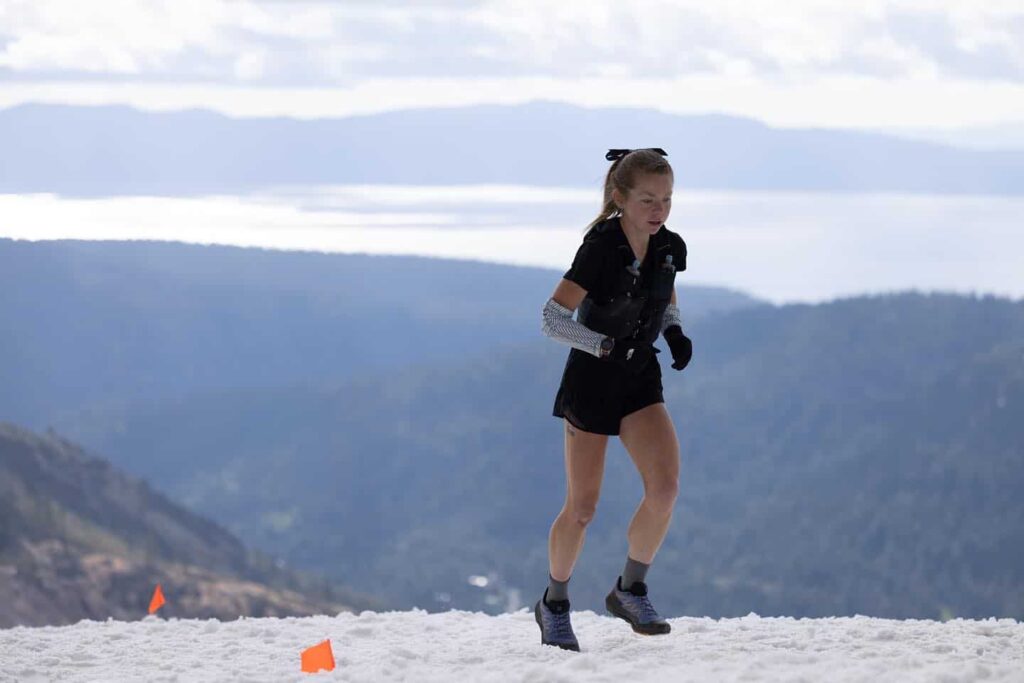
Tricks of the trade
Coaches also help athletes plan out their race strategy, particularly for longer races when the logistics — considerations like food consumption and resupply, hydration, and utilizing pacers —become more difficult. At Herman’s first 100K race, which she ran last year, she ran into problems on the course that left her with wrenching stomach pain. She ended up walking through the finish line.
“It really opened my eyes to how much more planning goes into the bigger distances, and how much more dialed you have to have all your logistics,” she adds.
A recent experience pacing a 27-mile section of the Cocadona 250 for Annie Hughes, who won Leadville 100 last year, was an eye-opener. “That was really cool to see how she prepares. She has a whole Google Doc with everything planned — what time she was going to be at aid stations, exactly what fuel she would need her crew to replenish at each station, and plans for her pacers,” says Herman, who is using Hughes’ personal race planner, Olga, for her own upcoming Leadville 100 race.
Herman says that the use of pacers is typically reserved for races over 50 miles. “You usually don’t get them until a certain point in the race,” she notes. While runners can elect to utilize multiple pacers over the race’s course, they can only have one at any given time.
She adds that the role of pacers is oftentimes safety-focused — encouraging and pushing the racer, absolutely, but also ensuring the runners stay on course, and that they’re consuming enough food and water to slog through to the finish line.
Key to race strategy — Herman notes, is to set, and stick to, a personal time goal in the longer races, because it’s incredibly easy to get caught up in chasing other racers. “I think that gets people into trouble really early chasing other runners…and these races can be like 20 hours long.”
As part of both her team and individual coaching duties, she helps her athletes practice the basics involved with logistics, like refueling during races.
“The bigger the distances, the more that fueling really makes a difference,” she adds. “The runners who can tolerate food well while they’re running tend to do a lot better, and your gut is like a muscle — you can train it.”
Hydration is just as important, especially when transitioning to a new climate. Herman recalls training in Gunnison when it was -10 degrees, and then traveling to Phoenix where it was 80 degrees to run a race just a handful of days later. “That can really flip your stomach, which is what happened to me [during the 100K],” she recalls.

A full summer of racing
During June’s Broken Arrow Skyrace in California, Benning placed 50th overall in a competitive field of more than 250 athletes in the 11K. Fellow Mountaineer athletes Cameron Smith and Kieran Nay finished in the top 10 overall in both the VK and the 26K races, while Herman took 32nd overall out of more than 500 participants in the 52K.
Later this summer, the team’s head coach Josh Eberly, along with Herman, will compete in the infamous Leadville 100 on Aug. 20. That event will be crewed by members of Western’s trail team.
The 100-mile race (160 kilometers) includes more than 15,000 feet of elevation gain, and is capped at 30 hours to complete. The course record for men is just under 16 hours, and just over 18 hours for women. The race will be Herman’s first career 100-miler.
You can follow along with the trail running team on Western’s Mountain Sports Instagram.
